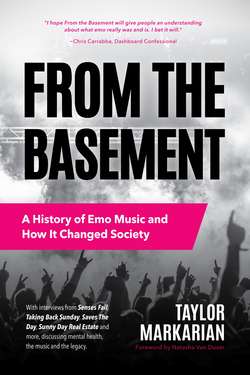Читать книгу From the Basement - Taylor Markarian - Страница 7
На сайте Литреса книга снята с продажи.
ОглавлениеForeword
By Natasha Van Duser
Music Journalist
There’s something peculiar about growing up listening to the entire My Chemical Romance discography on repeat, wearing really dark, ripped clothing, and being told that this is probably just some rebellious phase. It’s even more peculiar now that I’m an adult with two My Chemical Romance tattoos, a degree in punk rock history (yes, that’s a thing), and a career that stemmed from loving to dissect the lyrics I devoured on the daily. My name is Natasha Van Duser. I’m a music journalist and a professional makeup artist—it’s an odd combination, I know. But most subcultures of rock came to be because they were some sort of strange amalgamation of sound and attitude. Punk was abrasive but also insecure. Grunge found a way to be completely carefree while also being obsessive and introspective. And emo was sad but also incredibly uplifting. It was this bizarre mismatching of traits that made underground rock scenes flourish. It’s what made them so unique and memorable to this day. And it’s why there are countless retellings of rock’s history from a variety of different angles, like Gillian McCain and Legs McNeil’s Please Kill Me, Patti Smith’s Just Kids, and even Chuck Klosterman’s Killing Yourself to Live. There’s a humanity to rock music that reads far more authentically when seen through the eyes of someone who experienced the lifestyle themselves rather than a bone-dry history—a factual regurgitation of hardcore would simply be missing the point of the movement entirely. So, when I heard that Taylor Markarian was writing her own history of emo, I knew it would not only be told from all the right perspectives, but that it would also be as genuine as the scene itself.
I met Taylor when I was eighteen years old. We were at a really shitty party in a New York University dorm, and she walked in wearing a Motionless in White hoodie. I loved that band at the time and marched right up to her, red solo cup in hand, and said “I love Motionless in White!” She looked me up and down with a confused countenance I have yet to see since. I was wearing flip-flops, Hollister shorts, and a purple baby doll top I got from Pac Sun; at this point, I didn’t have any of the tattoos that now cover the majority of my body. So, I started naming my favorite songs off of the band’s debut album Creatures in response to her hesitation. I also believe I said something uber creepy along the lines of “We’re going to be friends now!” But alas, from that day forward, Taylor Markarian became not only one of my best friends, but also one of the best coworkers I’ve ever had.
We would edit each other’s college papers, share bands we both loved, and go to shows (we even threw our own basement shows). Down the road we would cofound the web publication HXC Magazine and write together for Alternative Press for a number of years. Eventually, my love for art and makeup drove me away from a full-time writing career, but Taylor’s love of music journalism and history only got stronger. As of today, she’s written for Alt Press, Substream, Loudwire, Kerrang!, Revolver, and a handful of other publications. She’s been backstage with Hawthorne Heights, had coffee with Frank Iero, been in a Senses Fail music video, and chatted about tea with Ian MacKaye. She’s interviewed a plethora of musicians, written countless record reviews, and probably gone to more shows than she could name. But, most importantly, what qualifies Taylor to write this book more than anything else is that she was never an outsider looking in. Taylor grew up at the height of emo, embraced the culture she’s speaking about, and now has the connections and skills to put down a basement history of a genre that was so much more than just a phase.
Emo is a music period that is still extremely relevant today, even though MySpace and the value of a CD have basically gone extinct. From local Emo Nights to modern hip-hop to fashion week runways, emo pokes its eyeliner-adorned head all throughout contemporary pop culture. And, while this book gives you a concise history told from the mouths and minds of the people who were there and the pivotal players that turned it into the monstrous boom that it became, there’s also a sense of nostalgia that you can’t quite escape. Within these words, you don’t just get to hear about bands playing college cafeterias or insider studio sessions dissecting some of the most memorable lyrics. Instead, you get to feel as if you’re there, right then. Reading this book will take you back to being a fifteen-year-old kid going to basement shows and summer festivals, screaming along with words you may or may not have tattooed on you now. Though the height of emo has had its heyday, the legacy it left behind is still standing strong, and this book is here to make sure everyone knows it.
